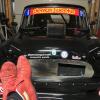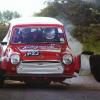Master Brake Cylinder Yellow Tag, How Install?
#1

Posted 06 June 2017 - 08:55 PM
Witch output are for the rear brake line and witch are for the front?
#2

Posted 06 June 2017 - 09:12 PM
I run the same and the answer is.
Top is for the front.
Bottom is for the rear.
Heres a picture if mine.
Attached Files
Edited by Rapidmini59, 06 June 2017 - 09:15 PM.
#3

Posted 06 June 2017 - 11:23 PM
Err why no PDWA?
#4

Posted 06 June 2017 - 11:58 PM
Err why no PDWA?
They have the float switch in the MC Lid, so if there's a fluid drop, that brings on the 'Yr gunna die' warning lamp.
Edited by Moke Spider, 06 June 2017 - 11:59 PM.
#5

Posted 07 June 2017 - 12:04 AM
Err why no PDWA?
They have the float switch in the MC Lid, so if there's a fluid drop, that brings on the 'Yr gunna die' warning lamp.
And pressure regulation is done on piston size? Only Mini with a dual circuit that I have had had the diagonal split.
#6

Posted 07 June 2017 - 03:07 AM
Err why no PDWA?
They have the float switch in the MC Lid, so if there's a fluid drop, that brings on the 'Yr gunna die' warning lamp.
And pressure regulation is done on piston size? Only Mini with a dual circuit that I have had had the diagonal split.
The Split systems were done one of two basic ways, diagonal and front / rear. We had front / rear here.
The Yellow Tag M/C has a stepped bore with different size pistons for each circuit, so it can't be used in a diagonal set up.
For Rear Wheel Pressure Regulation, it can be done one of 4 ways using factory parts with a front / rear split set up;-
1. The Brake Limiter Valve as fitted on many Front / Rear split set ups (FAM7821). I don't rate these.
2. The Inertia type Valve that was used for a short while as fitted to the side rail of the rear subframe. These are great.
3. The original Pressure Shut Off Valve as fitted to nearly all Single Circuit Brake Systems.
4. Appropriate sized Rear Wheel Cylinders. Depending in what's up front, these could be anything from 1/2" to 3/4". This is how the Diagonal Split Systems are done to prevent Rear Wheel Lock Up. They have no shut off valve what so ever and when you think about this system, it would be quite difficult to do one. None the less, the same principals and wheel cylinders can be used in a Single or Tandem set up, though, with the later stepped bore M/C, you probably need to adjust the size a little.
#7

Posted 07 June 2017 - 07:23 AM
I have used the top output for the rear brakes
#8

Posted 07 June 2017 - 07:29 AM
I have used the top output for the rear brakes
and there is your problem.
change it around.
#9

Posted 07 June 2017 - 03:21 PM
When you bleed it, it needs to be fully open then adjust afterwards.
Wind in the direction of the arrow stamped in the top face of the knob, fully adjusted will give you 57% reduced braking on the rear.
Are you running disc's on the rear like me.?
#10

Posted 19 June 2017 - 06:35 PM
Two follow-ups please:
Why would they flip the rear/front line outputs? Doesn't this make the rears your last resort instead of the front? I'd think it should be
otherwise as on the old masters. Even though the valving changes to allow for reduced or more rear brake pressure on the bottom output?
My Mk3 has the Regulator Pressure Valve in the center of the rear subframe, but someone added a manual adjustment valve to the
line for the rears, up on the firewall under the master. Am I right to assume that if I've adjusted it down on the firewall, then the
rear valve is truly redundant and just doesn't do any work? -Or would it also take rear pressure down further in addition to what the manual
unit has done?
#11

Posted 20 June 2017 - 05:10 AM
The earlier Tandem Master Cylinders (Green Tag usually) had a continuous bore in them, ie, the bore (and pressure / volume displacement) is the same for both circuits. With these, the fronts are to the bottom as for some countries (like ours) the volume of fluid in the reservoir must be enough such that the front brakes can go from new linings to metal to metal contact without topping up, also the lower piston is direct connected to the pedal, however, the upper piston is hydraulically coupled to the lower piston. Some countries also require that the circuit for the front bakes be direct connected. This is why they are connected up this way.
The Yellow Tag cylinders have a Stepped Bore, with the upper being a smaller diameter, so for a given mechanical pressure on the piston, the upper piston while displacing less fluid volume will have a higher pressure output than the lower (bigger bore) circuit. This is to allow for an installation without a servo and still have acceptable pedal pressure. I'll add here that in some countries (like Aust) these are not legal for road use as they don't meet the requirements above.
In regards to your adjustable shut off valve, it is highly likely you could do away with the fixed on in the rear subframe and just rely on that on the bulkhead, however, if you were to adjust the manual valve to a point where it would allow the rears to lock, the second valve on the subframe will still prevent this. Normally the fixed valves are set such that there could be more rear braking, however they are conservative. Using just the manual valve could allow you to have more useful rear braking, however, I would strongly suggest setting it under the worst conditions, ie, lots of weight in the front of the car, a near empty fuel tank and nothing in the back at all, and in the wet on a slippery road.
#12

Posted 20 June 2017 - 08:06 PM
Great info there. I appreciate your thoroughness. I take it the reservoir design might compensate for the the safety/failure limits?
Even though the rears would fail lastly, the amount of fluid available would sustain the front brakes throughout their full usage and
lifespan? Does the stepped bore still work as hydraulically coupled (as the older system), or is it now a direct connection?
-And on my pressure adjustments issue, to save some work and plumbing if I choose to eliminate the that rear subframe unit, could it be as simple as removing the replaceable spring in the regulator unit that does the work, rendering the piece as just an open T-connection?
Although I am tempted to leave it as is for now until I can experiment under driving conditions and see what the brake feel is like. (I'm still
wrapping up the body and plumbing work before an engine teardown, so I might be a month or so off from that), but I'd still be interested
in your thoughts. I would imagine the Mokes can get quite dancing in the rear, assuming what the weight distribution looks to be?
Many thanks --J
#13

Posted 20 June 2017 - 08:54 PM
All tandem master cylinders must have at least one circuit that is hydraulically coupled.
The reason for that is in an example, if you pressed on the pedal and they were direct coupled, then say the rear brakes take up and pressure is built up there, then the shut off valve closes. Pressure will then go up in the rear circuit but there's nothing left to move, so it won't allow any further pedal movement, hover as the fronts need more braking power, they nearly always have bigger pistons and so need a LOT of fluid displacement volume before they will start to work and that can only come from more pedal movement, which won;t be available as the pedal will have gone solid on the rears. Hope that makes sense.
The only direct tandem set up that I'm aware of is that which uses a balance bar and was not originally fitted to Minis. This usually entails some major work to fit up as a completely different pedal box is needed.
Yes, you can remove the guts from the existing Pressure Limiting Valve, it'll be more than just the spring though, there's also the piston in it which you'll need to also take out.
Curiously, Mokes have the highest shut off pressure of all the factory valves (390 PSI, Minis are typically 250 - 300 PSI) giving more rear braking. While the back end of a Moke does look light, there's actually a fair bit of steel in them for reinforcing etc. I do love to get the rear end dancing all the same ![]()
<EDIT: Just coming back to the standard Master Cylinder, while for normal operation, the circuits are hydraulically coupled, in a fail mode, they will direct couple, but at a very low pedal position. Here's an exploded diagram of the Green Tag M/C
You can see that Seal #10 is 'inverted' to how they would go in to any other cylinder. This is how the upper circuit is hydraulically coupled to the lower one. You can also see that it's only spring #11, between the two pistons - hardly enough to put any braking effort between the circuits! The 'pips on the tops of the pistons (the upper one being quite long) is how they couple in a fail mode.
Edited by Moke Spider, 20 June 2017 - 11:51 PM.
#14

Posted 21 June 2017 - 07:32 PM
So just to clarify, -in a catastrophic failure (ie- loss of fluid from reservoir) would you be left with only rear braking or does the spring #11
help to keep the upper (front) circuit active using the remaining fluid from the lower reservoir input?
I'm just having trouble with the appearance that rears are the last resort, when the greatest braking comes from the front.
#15

Posted 21 June 2017 - 08:47 PM
Theoretically, you'd be left with which ever circuit was still healthy, it'll be the rears if there was a front failure, but likewise, you'll have fronts if there's a rear failure.
If you had a front failure (the lower circuit), the 'pip' on the piston 13 would directly contact the lower part of piston 9 and press on that giving rear brakes.
Likewise, should a rear failure occur, piston 13 would hydraulically operate piston 9 in the normal way, piston 9 eventually bottoms out on it's 'pip' and allows pressure to be made in the front circuit.
There were also used on the diagonal split set ups too, which would leave you with a front and a rear wheel on opposite sides. It is because the Yellow Tag Master Cylinder has a stepped bore that they cannot be used in these set ups.
0 user(s) are reading this topic
0 members, 0 guests, 0 anonymous users



















